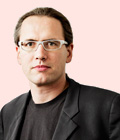
|
Martin Tamke
Associate Professor
Centre for Information Technology and Architecture
Copenhagen
Biography
Martin Tamke is Associate Professor at the Centre for Information Technology and Architecture (CITA) in Copenhagen. He is pursuing a design led research on the interface and implications of computational design and its materialization. He joined the newly founded research centre CITA in 2006 and shaped its design based research practice. Projects on new design and fabrication tools for wood and composite production led to a series of digitally fabricated demonstrators that explore an architectural practice engaged with bespoke behaviour. He is considered a leading researcher in the emerging field of digital production in building industry with successful engagement in several research and industry based projects. Currently he is involved in the 7th framework project DURAARK, pursuing research into the creation of semantically rich links between Point Clouds and BIM in architectural workflows, the Danish funded 4 year Complex Modelling research project and the Horizon2020 project InnoChain, investigating future digital workflows between the engaged industry and academic partners.
Abstract
DURAARK – Enriching BIM and Point Cloud data for the use in building lifecycles
BIM models enable today digital lifecycles for Buildings. Creating and maintainig the necessary data is however an expensive endeavor, as building related data is too often not or just partially existing or already outdated.
The European research project DURAARK (www.duraark.eu) investigates hence means to generate and maintain semantically rich BIM models from incomplete datasets. Using concepts from linked data and computation allows to create meaningful architectural information from an overlay and linkage of existing architectural data, such as 3d data and 3d Point Clouds.
Especially Point Clouds from Laser Scans or other 3d registration technologies are today the tool of choice for the generation of precise and complete documentations of the current state of building structures. They are however data heavy and cannot be integrated into the existing workflows of the building industries, which uses structured BIM models following international standards such as IFC.
The DURAARK project developed techniques for the fully automatic generation of BIM models from indoor point cloud data. A high-level semantic segmentation of the formerly unstructured point clouds allows to separate them into stories and rooms and to detect features, such as window, doors and interior objects. While this approach creates data, which can be directly used in Facility Management processes, the methods produces as well further data, as attributed spatial graphs, that integrate into planning processes of asset managers.
Further DURAARK tools, as i.e. the automated difference analysis, allow to quickly validate existing BIM models and detect incomplete, outdated or low-quality BIM data, while semantic enrichment tools allow to link the data of models to already existing ontologies in the world wide web.
DURAARK approaches have been evaluated with stakeholders, such as the Danish land surveyor company LE34 or Denmarks fourth biggest real estate owner Copenhagen Properties. The talk will report on the possible applications of the developed approaches in architectural design and building management and comment on the possible benefits for the building profession.
|

